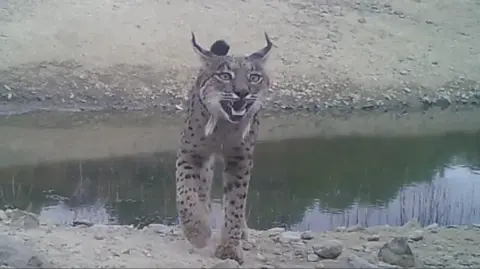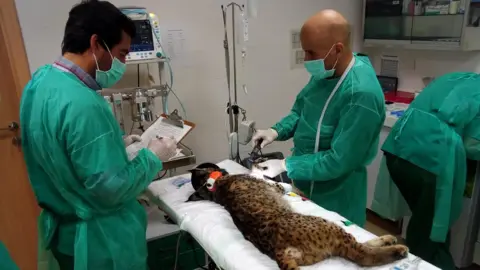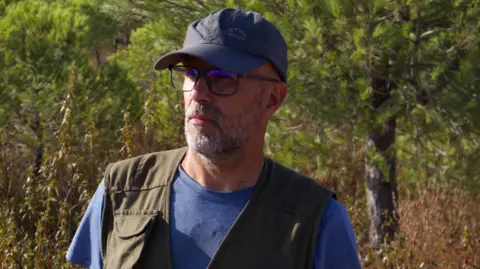
 CNRLI
CNRLIWith its leopard-like spots, Navarro – a male lynx – calls out during mating season as he walks towards his camera trap.
Measuring less than 100 cm (39 in) long and 45 cm high, the Iberian lynx is a rare sight. But there are now more than 2,000 animals in the wild across Spain and Portugal, so you're likely to see more of them than you were 20 years ago.
“The Iberian lynx was very close to extinction,” says Rodrigo Serra, who runs the breeding program in Spain and Portugal.
At the lowest point, there were less than 100 lynxes remaining in two groups that did not interact, and only 25 of them were females of reproductive age.
“The only cat species that has been threatened at this level has been the saber-toothed tiger for thousands of years.”
The decline in lynx numbers is due in part to more and more land being used for agriculture, higher road mortality, and struggles for food.
Hares are the lynx's primary prey, and two epidemics have reduced their numbers by 95%.
By 2005, Portugal no longer had any lynx, but it was also the year Spain saw the birth of its first litter in captivity.
It took another three years before Portugal decided on a national action plan to conserve this species. A national breeding center for the Iberian lynx has been built in Silves in the Algarve region.
Here they are monitored 24 hours a day. The goal is twofold: to prepare them for life in the wild and to mate them for reproduction.
Serra speaks in a whisper, because even from a distance of 200 metres, you can cause stress to the animals in the 16 pens where most of the animals are kept.
However, sometimes stress is exactly what the lynx needs.
 BBC/Antonio Fernandez
BBC/Antonio Fernandez“When we notice a litter getting a little more confident, we go in and chase them and make noise until they get scared again and climb the fences,” Serra says. “We train them not to approach people in the wild.”
This is partly due to their protection, but also to stay away from people and their animals. “Lynx should be lynxes, not treated like house cats.”
So the lynx never associates food with people, but is fed through a tunnel system in the center.
Then, when the time is right, they are released into the wild.
Genetics determines where they will end up, to reduce the risk of inbreeding or disease. Even if the lynx was born in Portugal, it could be transported to Spain.
Pedro Sarmiento is responsible for the reintroduction of the lynx in Portugal and has studied the Iberian lynx for 30 years.
“As a biologist, there are two things that catch my attention when I deal with lynxes. They are an animal with a fairly small head relative to their body and unusually wide feet. This gives them the drive and ability to jump, which is rare.”
The breeding program and the return of the lynx have been hailed as major successes, but with numbers rising there could also be problems.
Since the lynx is often released on private land in Portugal, organizers of the breeding program have to reach an agreement with the owners first.
 BBC/Antonio Fernandez
BBC/Antonio FernandezWhere the animals go next is up to them, and although there have been some attacks on chicken coops, Sarmiento says there haven't been many.
“This can lead to unease among local residents. We have reinforced the cages so that the lynx cannot access them, and in some cases we continue to monitor the lynx and scare them away if necessary.”
It tells the story of Lítio, one of the first lynxes released in Portugal.
For six months Lítio stayed in the same area but then the team lost track of him.
He eventually made his way to Doñana, a national park in southern Spain where he originally came from.
Since Lítio was ill, he was treated and then returned to the reproductive team in the Algarve.
Within days of his release from the centre, he began returning to Doñana, swimming across the Guadiana River to reach Spain.
He disappeared for a while, but was eventually returned to the Algarve.
 BBC/Antonio Fernandez
BBC/Antonio FernandezWhen he was released a third time, Lítio did not venture back to Spain, but rather walked 3 kilometers (2 miles), found a female and never moved again.
“He's the oldest lynx we have here, and he's had quite a few cubs since then,” Sarmiento says.
Three decades after Spain decided to save the lynx, the species is no longer threatened with extinction, and Sarmiento hopes it will reach proper conservation status by 2035.
For this to happen, numbers would need to reach 5,000-6,000 in the wild.
“I've seen species disappear. It's surreal that we're in a place where we can see lynx in the wild or through camera trapping almost daily,” Sarmiento says.
The cloning team is not complacent and there are risks involved in their work. Last year, 80% of lynx deaths occurred on roads.
But for now, they feel confident in saving the Iberian lynx.








